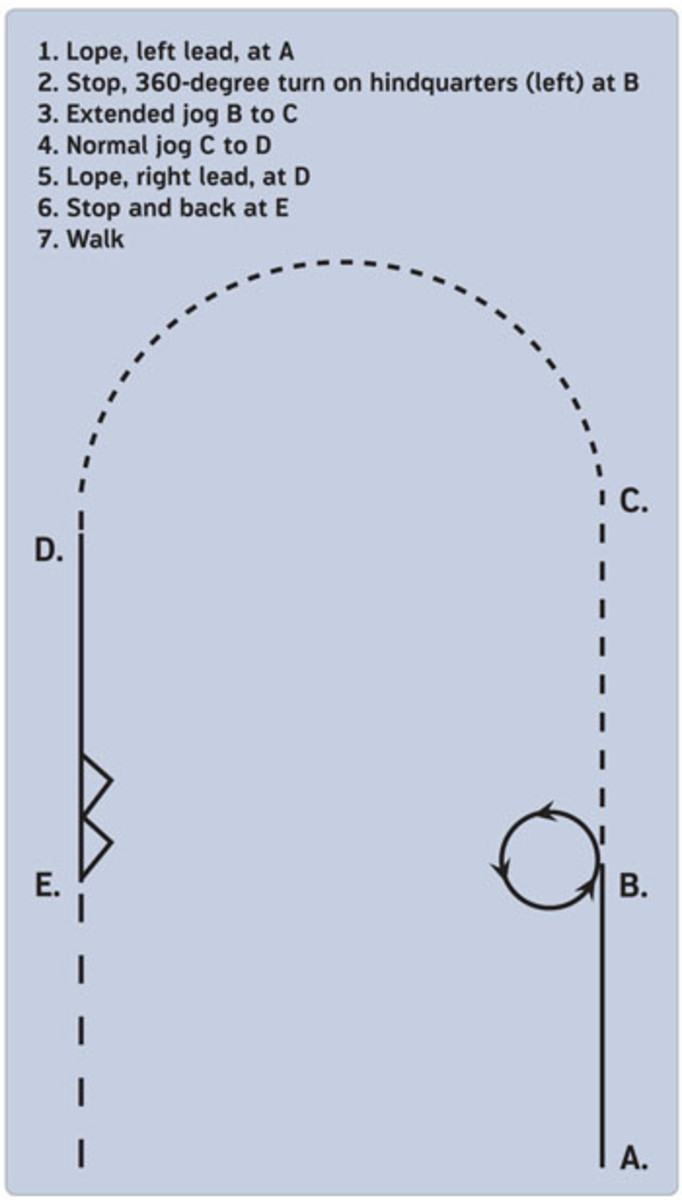This pattern looks deceptively simple, but it requires control and finesse. With only 60 feet between consecutive markers, you’ll need to be well prepared for challenging gait transitions, halts, an extended jog, a pivot, backing, and a counter lead. For a top score, you’ll need to smoothly connect the transitions, while staying in good form.

Begin this pattern by lining your horse up so that his nose is even with Marker A. If you can attain the left-lead lope directly from the standstill, you’ll score higher than those who walk a step or two first. Jogging into the lope incurs more penalties.
In a good lope departure, your horse remains straight (without you pushing his hip over to get the lead) with his head and neck level. Sit up tall and straight— don’t lean forward attempting to get the lope. Be ready to go with him without getting thrown backward by the motion.
Drop directly from the lope to a square, quiet halt with your horse’s nose directly in line with Marker B. Avoid dribbling down into walking steps first. Sit straight without falling forward, or leaning back with your feet braced in front of you as he halts. Show a definite halt, but hesitate no longer than it takes to count to three before beginning the 360-degree turn.
The 360-degree turn should be a pivot over the inside (left) hind leg. Don’t let your horse shuffle around in a little circle, moving both his front and hind feet. Keep his body straight from head to tail or slightly bent in the direction of the turn. Don’t look down or straight between his ears—keep your head up and look through the turn at about a 45-degree angle.
Without hesitating, flow smoothly out of the pivot into the jog, and look straight down to the end of the arena. Make sure you get the jog first, then extend it within the first couple of strides. If you ask for extension too abruptly, your horse may lope, which incurs a large penalty. Don’t push your rein hand forward to ask for the extension—it’ll round your shoulders and hunch your back.
Be sure you achieve a true extended jog so I will see a distinct difference between the normal and extended jogs. As your horse’s nose reaches Marker C, ask for the normal jog, but not too strongly or he may walk. Ride a nice, round arc around the end of the arena so it brings you into the next maneuver on a straight line. If you cut across the arena, you’ll have to make an awkward turn at Marker D. Sit tall, and look through the turn.
Getting the lope on the right lead at Marker D is tricky. Coming out of a left arc, your horse will expect a left lead. Hit a straight line a stride or two before the marker, be clear and firm with your cues, and move him right up into the right-lead lope as his nose passes the marker.
Keep a soft, steady pace at the lope. If you’re too aggressive asking for it at Marker D and your horse surges toward the in-gate, he could pick up too much speed making for an ugly halt at Marker E. Or, if he really gets strong, he could shoot past the marker. Use finesse in this fairly short 60-foot distance.
The halt should be prompt, square and level, with your horse’s nose at Marker E, and without dribbling down into the walk first. He should stop with his hind end well under him, not trailing out behind, and he shouldn’t fall forward on his front end. Count to three, then back up approximately one horse length. Walk forward on a straight line to end the pattern. n
John Letham and his wife Debby operate Letham Training Stables in Yukon, Oklahoma. John is a carded judge with the ApHC, APHA, PtHA, PHBA, IBHA, POA, and NSBA, and presides at about 20 shows per year. As a trainer with decades of experience, he has a keen eye for riders who exhibit winning form and function.







